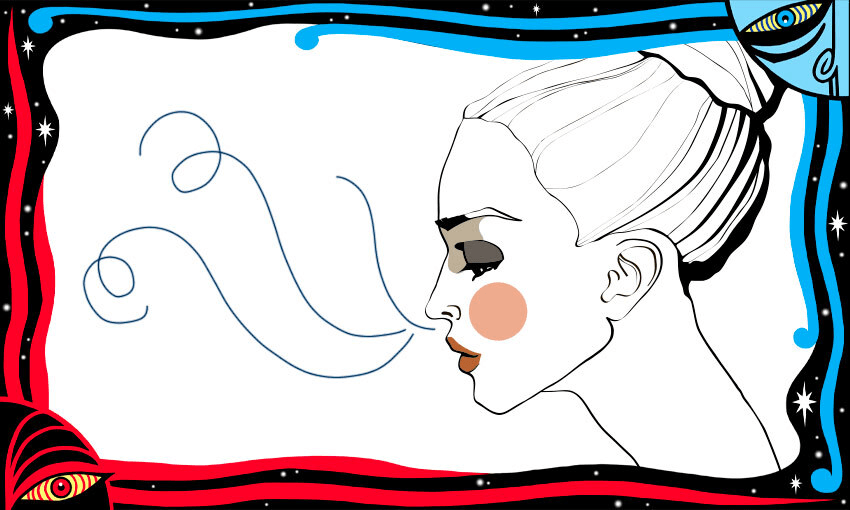Māori are among a number of cultures whose understanding of breathing goes beyond the simple act of inhaling and exhaling.
“Tīhei mauriora!” is a common expression in te reo Māori. It acknowledges the breath of life, and is expressed on the pae during whaikōrero or mihimihi. It refers to the Māori creation story when the first human was fashioned from clay in the form of a wahine. The hongi symbolises this first exchange of breath between atua and tangata.
From time immemorial, we’ve been aware of our breath.
There are many kupu for “breath” and its related functions. In his book Tikanga Māori: Living by Māori values, Tā Hirini Moko Mead defines “hau” as vitality of human life and vital essence of land, while he translates “hauora” as health, spirit of life and vigour. These explanations depict a Māori worldview that is intrinsically connected to the natural world. They connect us to the environment and weave our beliefs around hauora back to that very first breath.
“Hā” is another term associated with breath and breathing, but can also be used to mean essence, tasting and intonation.
Tei Nohotima (Ngāi Tūhoe), a revered expert and source of Māori knowledge, uses the kupu Māori “hēhē” for breath and breathing. In his younger years Nohotima was exposed to elders who were versed in traditional esoteric Māori lore. Referencing the kōrero of one of his teachers, Anaru Kupenga, Nohotima says Māori breathing techniques and beliefs are “how we receive and instill the breath of life”. He also refers to the late Dame Kāterina Te Heikōkō Mataira, a traditional knowledge-holder who taught him that “through breathing, we are giving light and energy into the atmosphere”. He also recounts how Dame Kāterina would describe goosebumps as the receptors and transmitters of energy.
Our mōteatea and pātere, two different forms of traditional Māori chants, are examples of cultural breathing techniques that have been practised and sustained over the generations, Nohotima says. Some chants are lengthy and require a unique type of fitness to recite while keeping in time with the fast-paced rhythm. He talks about how karakia demands knowledge and experience of nose breathing and engaging the diaphragm. These breathing techniques are widely practised by the many kapa around the country when training for and performing haka. Students of these cultural practices are often taught to breathe through their nose in order to maintain a steady flow, to sustain the tempo, to maximise the use of air and ensure that the words are being delivered correctly without disruption.
This mātauranga can also be applied in our daily life to improve our health by becoming more conscious and aware of how we breathe.
We often don’t think about breathing until it’s a health issue, or our significant other pulls us up about our wheezing when we’re out for a hīkoi, or when we’re called out for snoring during noho at the marae. It’s easy to fall out of sync with these natural bodily functions especially in the fast paced, tech-heavy modern society we’re living in. But new information is emerging about the benefits of focusing on our breath to improve our health.
Try taking a deep breath. If you inhaled through the nose, from your stomach or diaphragm, you’re on the right track.
Now, try breathing in for four seconds and exhaling through your nose for at least eight seconds, then repeat. This is the basis of the Buteyko Method, which recommends engaging in mindful breathing practice for four minutes, four times a day, every day.
Originating in the 1950s from Russian physician Konstantin Buteyko, the breathing exercise programme is based on the belief that hyperventilation, or over-breathing, is the primary cause of a number of disorders such as asthma, high blood pressure, sleep apnoea and panic disorders. Artist Nikau Hindin (Ngāi Tūpoto) learnt the Buteyko Method 15 years ago after suffering from sports asthma. She says she would hyperventilate and suffer from panicked breathing after pushing herself too hard.
“I didn’t have an asthma attack again. I’ve been a nose-breather ever since. It changed my life,” Hindin says.
Hindin says the key to improving the function of our hā is learning to breathe in and out through our noses, rather than through our mouths. She says it is a common misconception that CO2 is purely a waste product, but our bodies actually need it to “bump” the oxygen off the red blood cells, and push it into the cell tissue – our muscles – so we can create energy.
“Breathe through your puku,” she says. “A lot of us breathe quite high up in our chest, so it’s really important to use and exercise our diaphragm, because it’s a muscle, along with our intercostal muscles.”
The book, Breath: The new science of a lost art by James Nestor, published in 2020, has brought the discussion about nose-breathing into the mainstream. Nestor travelled the world looking at different breathing techniques from cultures across the world, including Pranayama, Sudarshan Kriya and Tummo. The premise of the book is that many of us have forgotten how to breathe properly.
Using the mātauranga of kapa haka, karakia, mōteatea and te reo, we can relearn what our elders knew innately. Connecting it with contemporary knowledge and understanding about the breath from other cultures gives us an even bigger picture of its importance.
Tei Nohotima says we acknowledge the exchange of light and energy with our taiao every time we say “kia ora”, or engage in hongi. The uncertainty shrouding us at the moment can be suffocating, but in the moments when the taumaha weighs heavily on our chest, constricting our airflow, we can use these examples to help us breathe through it.
Follow Nē? on Apple Podcasts, Spotify or your favourite podcast provider.





